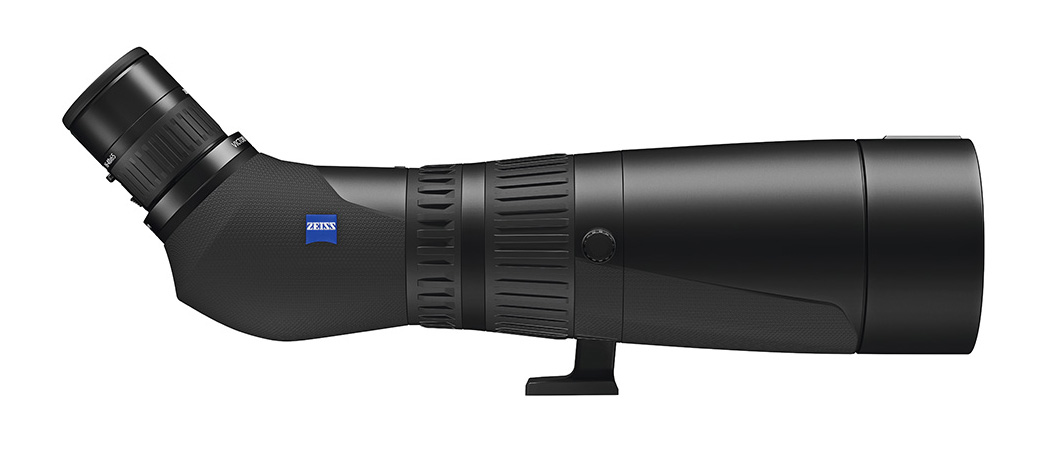Zeiss Victory Harpia 85 mm telescope
The idea that development and design in optics have peaked is being contested by Zeiss with the recent unveiling of the new Harpia spotting scope. The model represents a radical change in optics technology.
Two new flagship models, with 85 mm and 95 mm objectives, form part of the manufacturer’s Victory range of premium optics, and their design opens up a number of interesting possibilities for further development.

So, what’s new and why is the Harpia unique? The wide-angle zoom mechanism has been placed in the objective end of the scope near the focusing wheel, not in the eyepiece, which allows greater flexibility in the way the image is presented. The geared focusing wheel is dual speed and can be adjusted in parallel with the zoom control using just one hand, improving operational ergonomics. It also means a slightly smaller eyepiece can be used with the body.
The results of this were immediately apparent while field testing the 85 mm model, which provides a magnification range of 22-65x. The Harpia has a marvellously wide field of view. It’s a massive 63.2 m at 1,000 m at the lowest (22x) magnification, which would appear to be unparalleled by any other birding scope. At 65x, it’s still an impressive 21 m at 1,000 m, and at no time when using the zoom did I experience the feeling of ‘claustrophobia’ that can arise from the tunnel-vision effect encountered when operating the zoom on many other scopes. The ‘apparent’ field of view remains at 72° throughout the full range of the zoom, eliminating tunnelling.
Given the extraordinarily wide field, it might be expected there would be some field curvature or a loss of sharpness at the edges of the image. This simply didn’t happen and it remains sharp across the entire width of its field, even at the top of the magnification range.
Familiarising myself with the close proximity of the zoom control to the focusing adjustment took some time. Both wheels feature broad ribbing which offers serious grip. The zoom control, 25 mm wide, is designed to offer much more turning resistance than the focusing wheel, which is 40 mm wide, the two being separated by only 10 mm of scope body. The numeric scale on the zoom runs from 1 to 3, in 0.5 increments.
Operating the dual-speed focusing wheel presents little difficulty. Quickly turning the mechanism rapidly changes the focus between close and distant subjects, whereas lighter operation back and forth engages it for fine focusing. I estimated approximately 45° of rotational play covering the latter, which eliminates sensitivity and allows a perfect, sharp focus to be achieved, even at the highest magnification. In this respect it’s almost too forgiving!
Satisfied that the image was sharp and seemingly distortion free, I took a look at the overall quality. In a scope of this calibre, chromatic aberration (colour fringing) should be minimal. Fortunately, it runs at a very low level and even the acid test – Common Coots set against a background of reflective water – revealed little to cause concern. Resolution is also good and the distant American White-winged Scoter, way out in the waters of the Firth of Forth off Musselburgh, proved no match for the Harpia, the difference in eye-patch shape between this species and the accompanying Velvet Scoters being readily apparent.
Colours, too, are fine and natural, although the image is rather cold and, I felt, perhaps a little more contrast would be good, but this is personal. Pleasingly, there is little loss in image brightness across the magnification range.
Zeiss’s high-quality optical materials are integrated into the scope, including FL glass elements and dirt-repellent coatings. The body is smoothly rubber armoured with a slightly raised, fine mesh-textured area offering some additional protection around the prism housing and broadly along the underside of the body. The latter appears largely cosmetic, successfully enhancing the aesthetics and allowing perfect alignment of the 360°-rotating tripod foot in the default position. In a departure from earlier models, the tripod foot is not compatible with a Manfrotto 200 PL plate.
An objective lens cover sits within the pull-out hood, which means it can be removed or applied when the hood is both extended and retracted. The bayonet-fitted, removable eyepiece can be securely locked in, while the twist out eye-cup adjusts firmly to any desired extension. There’s also an optional stay-on case for a hefty £150 and a branded DSLR photo adapter and smartphone adapter.
Since the zoom is located in the body, it’s this end of the scope that offers potential development opportunities through the introduction of higher magnification.
There is no doubt that the Harpia is revolutionary, excellent and a true pleasure to use, passing a milestone and setting a new reference standard in optics. With price tags of £2,995 and £3,395 for the 85 mm and 95 mm models respectively, how hard will Zeiss have to work to convince new customers at the top end of the market?
Further info
- SRP: £2,995
- Size: 384x121 mm (body), 71x53 mm (eyepiece)
- Weight: 1,934 g (body), 220 g (eyepiece)
- Magnification: 22-65x
- Field of view: 63.2-21.0 m at 1,000 m
- Light transmission: not available
- Close focus: 3.5 m
- Gas-filled: yes
- Waterproof: yes
- Warranty: 10 years
Verdict
- Extraordinarily wide field of view
- High-quality image with no loss of sharpness at edges
- Contrast could be higher


